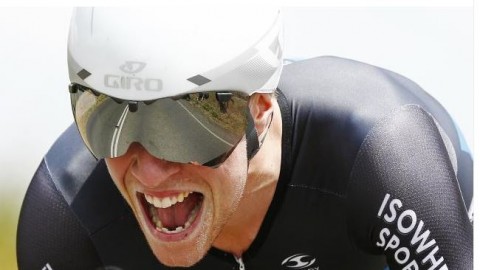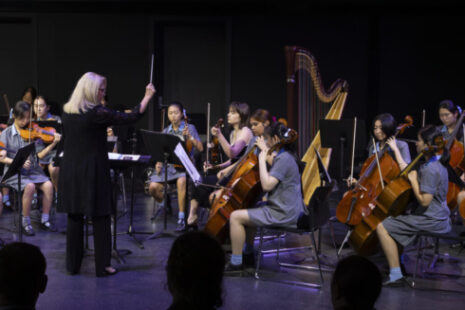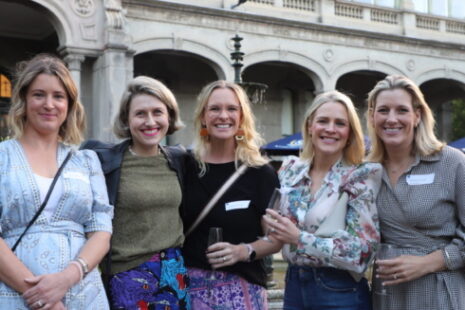Year 10 Rowing Coach Cycling success

Year 10 Rowing coach, Sean Lake continues to ride strong.
“Especially for time trialling, that’s all very similar, just knowing your body well and dealing with that pain,” said Lake, who lives in Melbourne and coaches a St Catherine’s School rowing team.
Taken from: The Coffee Ride #93, with Reece Homfray The Adelaide Advertiser, 13 January 2016
AUSSIE CYCLING FRESHLY BREWED EVERY WEDNESDAY MORNING, EXCLUSIVE TO ADVERTISER.COM.AU
LAKE’S STUNNING SWITCH CONTINUES
GET used to hearing the name Sean Lake.
The 24-year-old former rower produced arguably the ride of the national championships last week when he finished third in the elite men’s time trial behind superstars Rohan Dennis and Richie Porte.
That said, it’s hard to go past his teammate Pat Lane’s effort to finish third — one of only 15 to finish at all — in the men’s road race on Sunday.
Fittingly they have both been rewarded with a spot in UniSA-Australia’s team for the Tour Down Under.
Lake, the winner of the past two editions of the Grafton to Inverell Race, only started working with new coach Mark Fenner two months ago and is just a fortnight into his first season with new team Avanti-IsoWhey.
Having pulled the pin on his rowing career two years ago, Lake always had a suitable engine for cycling but only now is he starting to realise his potential.
His ride to finish third in the time trial — 1min 34 secs behind Dennis — made the peloton sit up and take notice.
“It only sunk in slowly and I’m still pinching myself even now,” Lake said afterwards.
“It was a little bit of a surprise to actually get the result.
“We talked about it and knew with the power numbers I was doing that we could get that sort of result, but with how you ride a time trial course and aerodynamics I’ve always been going a lot slower than my power would suggest.
“But finally managing to hit some potential was really good for a change.”
Lake was an international-level rower but turned to cycling after struggling to make weight for his category.
He is currently 77kg and when he was rowing he spent most of the year at 73-74kg.
“Basically I got to the point where I couldn’t get my weight down to 70kg repeatedly and was struggling with some serious fatigue problems, so I just had to step back a bit,” Lake said.
“It was going really well, I’d done three under-23 world championships and a year at the Australian Institute of Sport so from the outside things were really looking up.
“But the body said no and I tried heavyweight but it was a few steps back so I was pretty disheartened.”
Lake then took a year off, did some bike riding and was picked up by the African Wildlife Safaris team at the end of 2014.
He said there were lmany similarities between the two sports which made the transition easier.
“Especially for time trialling, that’s all very similar, just knowing your body well and dealing with that pain,” said Lake, who lives in Melbourne and coaches a St Catherine’s School rowing team.
“We did a lot of cross training on the bike because rowing is 60 per cent from your leg drive. It’s a really compatible sport.”
The structure of his season will depend on which race invitations the team receives but he hopes to compete overseas.
“I’d love to get as much experience as I can in some big UCI races. As well as that when I’m in Australia if I am racing some of the NRS I really hope to put some strong results on the board,” Lake said.
RACE FOR RIO IS ON IN
AUSTRALIA’S top road cyclists sent a message to Olympic selectors about their Rio ambitions in last week’s national championships but victory has not guaranteed them a spot on the team.
Selectors are looking for strong performances in the early part of the European season before having to finalise the team for the Games by the end of June.
Cycling Australia is yet to be officially notified of its quota for the road component of its team but current rankings have it working towards four men and up to four women.
Only the top-five ranked nations on the UCI WorldTour at December 31 secured five spots for Rio and Australia’s men finished eighth, while the women have until May 31 to secure their best possible ranking.
A brutal course awaits both the men and women for the time trial and road races in Brazil in August.
The men’s road race is 241.5km long and finishes with three 25km circuits — each with an 8km climb — which follows 12km of cobblestones and a windy section along the coast. The women face similar challenges over 141km.
The time trial is 54.5km for men and 29.8km for women with 1-2 significant climbs awaiting both.
Australia may be able to field two starters in the time trial but they are likely to have to come from the four selected for the road race.
CA high performance director Kevin Tabotta said it will take either a cyclist coming out of the Tour de France in outstanding form or one who has specifically targeted the race to medal in the men’s road race in Rio.

Rohan Dennis … frontrunner for Olympic spot. Picture: Matt Turner.
“I would say the road race course is difficult to very difficult,” Tabotta said.
“(To medal) it’s going to take someone coming off the Tour de France who is able to maintain good form and physical conditioning and with a great capacity to climb and descend,” Tabotta said.
“Or someone who has had the ultimate preparation in targeting the event so there will be two groups of riders.”
While the road race and time trials at last week’s national championships signalled a rider’s intent for Rio, selectors will be looking at WorldTour racing in coming months to determine the team.
Given selection must be made before the Tour de France, it means the Spring Classics, Giro d’Italia and races like the Tour of Suisse and Criterium du Dauphine may be crucial.
“The national championships have an impact in it’s the first indication that you’re interested in being part of the national team for the future,” Tabotta said.
“But it doesn’t need to be a selection race because the men and women take it very, very seriously, they want the national champion’s jersey and to take it back to Europe.
“It’s a good early-season sign of form for races such as the Tour Down Under, going into Asia and the Spring Classics.”
The road race course will suit riders such as Tour de France champions Vincenzo Nibali, Chris Froome and Spaniard Alejandro Valverde, who finished last year on top of the UCI WorldTour rankings.
Frontrunners for selection to the Australian team include the likes of Simon Gerrans, Richie Porte and Rohan Dennis, while Amanda Spratt put her name on the whiteboard by winning Sunday’s road race as did Katrin Garfoot in the time trial and Rachel Neylan is expected to be considered.
The total size of the Australian cycling team for Rio which includes road, track, mountain bike and BMX disciplines is expected to be 30-32 riders.
TO MOVE OR NOT TO MOVE
A FEW thoughts on the never-ending debate as to whether Cycling Australia should move the men’s and women’s road race from Mount Buninyong after only 15 of the 127 male riders managed to finish on the weekend.
The answer should be yes but not definitively.
For starters, professional cyclists who claim the course is too hard are missing a point.
Pat Lane was an NRS rider last year, albeit a top-level NRS rider, and has graduated to Continental in 2016, but he finished third on the weekend, as did Neil van Der Ploeg from the same team the year before.
They’re not on the WorldTour, they’re not paid big money to ride the best stage races in the world, but they simply made a decision to be in absolute rip-roaring form and condition by the first week of January and were rewarded.

Ruth Corset … rewarded for hard work. Picture: Con Chronis
And Ruth Corset, a 38-year-old mother of two who rides the women’s NRS, very nearly won the women’s road race, finishing second behind fulltime professional Amanda Spratt.
If those complaining the course is too hard put in the same type of work Lane and his Avanti teammate Sean Lake have in the past few months, they could finish in the top 10 too.
But realistically they’re not going to do that because for top-level domestic riders, the national championships is like their grand final, but for most WorldTour riders it is not.
I’m for a push to move the course but only on rotation, to mix it up, keep it fresh, and to take any predictability away not from the result but from the riders and their plans.
Ballarat deserves to keep the national titles and Mount Buninyong is a great location for the race but it would not hurt to move it around, find different finishes and keep even the riders guessing.
POWER TO THE METER
LIKE race radios, power meters on bikes and particularly in bike races divide opinion.
And Jack Bobridge’s explanation as to how he tactically rode Sunday’s road race gives rise to suggestions that maybe the power meter should be banned.
Not because it offers an unfair advantage but because it makes the sport a science.
“I tried to break it into sections — do the climb at threshold and all the descents at 300 (watts) or less so I could always ride threshold on the climb,” he said.
“I knew to take nine minutes back on the climb if I’m riding my threshold, most of the bigger guys are heavier than me and are going to have to do stupid numbers.
“They were going to pull back a bit of time but never nine minutes.
“Every time up the climb I really watched my power meter and knew what I could do. To do 60km/h downhill, to do 62km/h you’ve got to do an extra 60 watts so it wasn’t worthwhile.

Tactically brilliant … Jack Bobridge climbs Mt Buninyong on his way to the national road race title. Picture: Michael Klein
“It was worth putting that extra 60 watts up the hill and holding them off.
“It was a really tactical game in terms of watching the power meter … not pedalling (on the descents) conserving (energy) and eating and drinking all day.”
Very smart and full credit to him.
But if Bobridge didn’t have the power meter on and rode to feel, would we have seen a closer result, would he have gambled in the first place?
Race radios are criticised because they take the guess work out of cycling when the peloton is trying to reel in the breakaway.
As Bobridge showed on the weekend, power meters can do the same.
But then again, it’s one thing to plan to ride 400 plus watts up Mount Buninyong 18 times and another thing to actually do it and that is where the brute strength of body and mind is the most powerful weapon of all.




